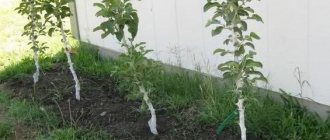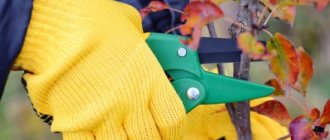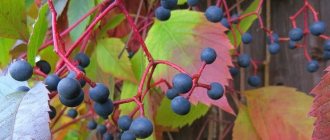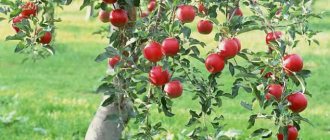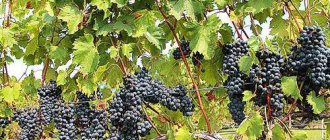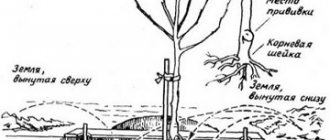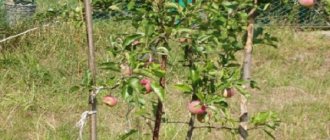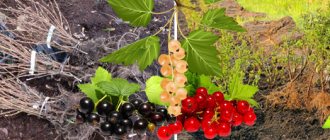Do you need to bleach apple trees?
Fruit trees, including apple trees, need whitewashing. Applying a light composition to the bark in the spring will protect against injury due to the bright sun. Tree trunks are dark in color, so they heat up significantly during the day. At night in spring, the air temperature drops noticeably. Because of this difference, the bark cracks. Infections and insects will quickly get into these cracks, leading to disease and death of the plant. Bleached trunks will reflect light, heat up less, and will not crack. Such protection is needed for both young and old plants.
Important! Painting trunks with whitewash in the fall is a pest control measure. Various insects inhabit the bark for the winter. With the help of whitewashing, trees are disinfected from adult insects, larvae, eggs, and pupae.
Preparation of the solution
Another important question is how to whiten apple trees in the fall. The type of coloring solution can be different and vary depending on the purpose for which this procedure is being carried out. A popular option is to prepare a lime-based solution; to create it you need to mix in equal proportions:
- quicklime;
- clay;
- any glue, wood or casein is recommended.
Fill the entire contents with water so that it makes up 50% of the total volume. The solution should be viscous, similar in consistency to sour cream. This whitewashing is needed to prevent pests and protect against frost.
If the tree is located in an open area, you can protect its bark from sunlight. To do this, you need to prepare a solution consisting of the following components:
- 300 g fluff lime;
- ½ glass of milk;
- glue in liquid form;
- 2 liters of water;
- 5 g copper sulfate;
- 5 g DDT in powder form.
This type of autumn whitewashing from apple trees is suitable for young seedlings and old trees. Its additional property is to protect tree bark from penetration of pests, eliminate their larvae and increase immunity to diseases.
On a note!
As the main composition, you can also use acrylic or water-based paint or a ready-made solution for whitewashing fruit trees, which can be purchased at a store for gardeners and gardeners.
Age of wood for whitewashing
Not all apple trees are whitened. Very young people are not subjected to this procedure. They are only wrapped for wintering, but without plastic film. Sometimes whitewashing is still carried out, but with a weak, gentle chalk solution. Lime will burn the tender bark and should not be used on young animals. It is better to use woven materials, burlap. When the tree begins to bear fruit, it should be whitened. After this, whitewashing is carried out annually.
Whitewashing of young trees
It is not recommended to bleach young seedlings that have greenish bark and wood that is not fully formed. The fact is that whitewashing compounds are quite aggressive and can burn the bark, causing disruption of metabolic processes in very young plants. Experienced gardeners process both young and mature crops. If young trees are not whitewashed at all, sun and burns can damage the seedling - and much more severely than whitewashing. Learn about grafting apple trees in the spring for beginners from this article.
In most cases, it is recommended to whiten apple tree seedlings - the damage from the sun and frost is much stronger than from chemical compounds. The main thing is not to exceed the proportions.
The main feature of working with young trees is to halve the concentration of lime in the solution. Instead of lime solution, you can use special water-based compositions, acrylic paints, and a silver biomask. How to save an apple tree if mice have eaten the bark here.
When is the best time to bleach apple trees?
The most common option is spring whitewashing of trees, but experienced gardeners carry out this procedure at least twice: in spring and autumn. The weather for work must be dry, so that the composition is not washed away by rain immediately, so that it is firmly attached to the bark.
Autumn whitewashing is carried out in October or early November. If the trees were not painted for the winter, then the deadline for spring painting should be postponed to February. If the apple trees overwintered under protection, then they are whitened in March or April. In May it is too late to bleach apple trees.
If the solution has managed to wash off the tree after spring whitewashing, then the protective procedure can be additionally carried out in the summer.
Why do you need to whitewash apple trees?
Painting trees in the fall is considered the main treatment that will save the life of a tree in winter .
The February sun is especially active, it provokes the movement of sap in the trunk. And the consequence of this process at sub-zero temperatures can be the occurrence of critical cracks. Spring whitewashing of apple tree trunks is considered the second most important procedure. It is produced in order to protect the apple tree from attack by insect pests , which at this time wake up after hibernation and are actively searching for food. In addition, in the spring season, unstable temperatures can provoke cracking of the bark, similar to winter.
In the summer , the painted trunk will no longer be able to attract sunlight so actively, which will prevent the appearance of burns on it . Therefore, updating the protective functions in July is mandatory.
Need for protection in young trees
Beginning gardeners are wondering: is there a need to whitewash the trunks of young apple trees? Opponents of this action argue that painting the bark before it gets stronger and becomes cracked is pointless. However, this opinion is erroneous, because the risk of burns in young trees is even higher than in mature ones . By whitewashing you will keep them healthy.
It is recommended to whiten apple seedlings younger than 2 years with chalk, because more aggressive lime can significantly injure their delicate bark. The following mixture will be a universal recipe:
- 2 liters of water;
- 300 g chalk;
- 2 tbsp. l. copper sulfate;
- 200 g of stationery glue;
- 200 g clay;
- 30 g karbofos.
Mix all components until smooth. This composition will not only prevent sunburn, but also increase the protective barrier against various diseases.
This solution can be used to whitewash young apple trees in both spring and autumn.
How to prepare wood for whitewashing?
In order for the treatment of apple trees to have an effect, it is important to properly prepare them for such a procedure. It includes three mandatory steps.
- Cleaning. The trunks of apple trees are removed from old bark, which is especially generously covered with lichens. Large segments are removed with a spatula or wooden spatula. Final cleaning is carried out with a wire brush. This procedure is best done after rain or when there is high humidity. Then the bark will be easier to remove. Removed parts must be burned to prevent the spread of infections and garden pests. For convenience, you can spread an oilcloth around the tree before cleaning.
- Disinfection. This stage of preparation for whitewashing is best done in dry weather so that rain does not wash away the disinfection solution. It can be done in several ways. You can spray the apple tree with a spray bottle of copper sulfate solution, paying special attention to the damaged areas. You can also wash the barrel with a solution of ash or ash with laundry soap. The main thing is to work with gloves. To do this, dissolve 2 kg of wood ash and a bar of laundry soap in a bucket of water.
- Covering wounds. After removing the old bark, cracks, depressions, and wounds may remain on the trunk of the apple tree. They must not be left open. Such recesses should be covered with clay mortar or special garden putty. A good protective agent is a mixture of manure and clay diluted in water. Only after these three stages can you begin to whitewash the apple trees.
See also
Description and characteristics of the Ural Nalivnoye apple tree variety, frost resistance and growing characteristicsRead
Errors
Inexperienced gardeners often make mistakes when whitewashing trees. Because of this, the procedure turns out to be ineffective or the tree, after a few weeks, begins to wither. In total, we can highlight several of the most common mistakes.
- Wrong choice of product. A highly concentrated solution or lime is dangerous for young seedlings. Burns may appear on the smooth bark of the trunk, which can lead to the death of the tree.
- Very thick solution. Usually this is prepared to make the whitewash layer denser in the hope that it will better protect the plant crop. In fact, such whitewashing will only negatively affect the development of the tree and will cause the bark to quickly begin to crack.
- Very liquid composition. The whitewash, which has a consistency similar to water, will quickly begin to roll down the trunk; it will not have time to soak into the bark, and therefore there will be no effect from such treatment.
- Incorrect timing. It is important to perform whitewashing before the onset of frost, otherwise there will be no benefit from it.
If you paint in accordance with simple rules, the effect will be quickly achieved - you will be able to protect your fruit fields in the garden from pests and external factors. If a mistake is made during processing, significant damage can be caused to them.
Annual whitewashing of apple trees in the fall is an important procedure. If you follow the step-by-step instructions for its implementation, choose the right coloring solution and all the recommendations, you will be able to ensure a safe winter for the plant crop.
Popular solutions and their preparation
Various compositions are used for whitening apple trees. But more often lime is used for this purpose. In cases where treatment of young trees is required, experts recommend replacing it with chalk.
Dye
Whitewashing with paint gives reliable long-term results. Use water-based varieties or acrylic ones. Water-based paint adheres well to the trunk and perfectly reflects the sun's rays, but does not have a pronounced disinfecting effect; it is more suitable for spring. Acrylic paint reliably protects the apple tree from pests, including fungal infections. No additional ingredients are required. The disadvantage of this procedure is its significant cost.
Lime
This is one of the most popular tree care substances. It is easy to use and lime is inexpensive. To make it better fixed to the trunk, you can add a little clay. It will add viscosity to the solution.
There is no point in whitening trees simply with “white water” with a low concentration of lime, it will quickly wash off, and you will have to paint the garden more than once.
The treatment solution is prepared with the following proportions:
- water - 4 liters;
- lime - 600 g;
- milk - 1 cup or instead PVA glue - 4 tbsp. spoons.
Stir all components well until smooth. To enhance the disinfecting effect, it is good to add another 2 tbsp to this mixture. spoons of copper sulfate. This will protect the apple trees from many diseases. You can replace copper sulfate with iron sulfate. But copper preparations should not be used too often, as it will accumulate in the soil and inhibit tree growth.
Other
In addition to paint and lime, clay and mullein can be used to whitewash apple trees. The first option is an excellent thermal insulation material that protects trunks from excessive heating or hypothermia, as well as from exposure to strong winds. This natural material does not block the pores of the wood, it can breathe.
The mullein solution, due to its adhesive ability, reliably fixes the mixture on the trunk. It also acts as a kind of fertilizer. To prepare the mixture, 2-3 kg of clay is mixed with 10 liters of water, then mullein is added until the mixture reaches the required consistency.
Popular compositions for whitewashing
When choosing a suitable solution for whitewashing, opinions may be divided, many prefer lime-based solutions, and some use special paints. So how to whiten apple trees?
Lime whitewash
Lime is an environmentally friendly substance that does not harm the environment. And its availability explains its popularity among most gardeners.
The disadvantages of whitewashing with lime include the fact that it is short-lived and is quickly washed off by rain , therefore it requires regular application to the trunk at least 2 times a year. Its protective functions extend purely to the negative effects of sunlight and frost, but do not in any way affect the impact of infections and pests . copper sulfate should be added to the finished lime mortar , and this will require additional cash costs.
Common composition for preparing whitewash solution:
- 1 kg lime;
- 8 liters of water;
- 0.2 kg of copper or iron sulfate.
Or you can give preference to another composition : chalk (2 kg), water (10 l) and clay (200 g). All components are thoroughly mixed so that there are no lumps, and infused for about 2 hours.
Paint treatment
To paint apple trees in spring or autumn, you can use water-based and acrylic paints. The protective functions of a water-based coating are similar to the action of lime, that is, it protects purely from exposure to the sun and low temperatures. But this paint lasts longer on the surface, which allows you to whitewash the wood less often.
As for acrylic paint , it has an extended spectrum of action and also protects the apple tree from the effects of pests and fungal spores. Ease of use does not require any additional actions, that is, just open a jar of the product and get to work.
The disadvantage of whitewashing apple trees with paint is that it is much more expensive, but it will be necessary to whitewash less often. At the same time, it is a chemical product, albeit a safe one.
Other formulations
You can use clay and mullein for whitewashing. This product has an unusual light green tint.
Clay helps protect the trunk from overheating, frost and dry winds, but the pores are not clogged, which allows the tree to breathe. Mullein gives the solution stickiness, which allows it to stick to the bark for a long period of time. It also contains many useful microelements that nourish the apple tree.
Video: how to whiten
How to whiten an apple tree correctly?
The composition is applied using a regular brush to previously prepared (cleaned) apple tree trunks. The composition should evenly and completely cover the wood, without gaps. If the apple tree is mature, then the brush should be wide. If desired, you can use a spray gun, but in this case the consumption of white will be wasteful.
See also
Description of the Geneva apple tree variety, when to plant and cultivation featuresRead
The height to which the white level should reach is at least 1.5 meters; it is better to paint apple trees at 2 meters. You can whitewash the trunk up to the first skeletal branch, as well as part of the branches up to their third part or even half.
You should also rake the soil at the base of the tree and paint it down 4-5 cm. After the protective layer has dried, the soil should be returned to its place.
To prevent the autumn whitewash from being immediately washed away by rain, you should protect the tree by surrounding it with a polypropylene bag. It is important to choose them white.
This material will reliably protect the barrel from moisture, but will not prevent air penetration. The trunk of the apple tree must be wrapped first with a thick rope and then with a bag. This will create an air gap. The product is fixed until spring. When the threat of severe frost has passed, it is removed.
Whitewashing old apple trees. Treatment of an old apple tree (tree 20 years old)
We begin to treat the old “neglected” apple tree.
- Using an iron brush and scrapers, we clean the bark, hollows, etc., and trim the branches.
- Iron or copper sulfate - with a syringe and a brush into holes drilled by caterpillars, into hollows and wherever your hands can reach, copper is better, iron quickly rusts and metal frames fall apart if you don’t wash the brush in time.
- Putty: thickly ground red lead on natural drying oil for bare trunks and saw cuts. To seal large holes and hollows - bitumen with drying oil; drying oil gives normal plasticity at T +15...+20°C.
- Whitewash: lime + copper sulfate + clay + gypsum plaster + wallpaper glue (I haven’t tried the glue yet, I hope the whitewash should be enough for a couple of months and it won’t wash off).
Common Mistakes
Whitewashing will not bring the desired results if done incorrectly.
Here are the main mistakes that inexperienced gardeners make:
- Low whitewashed trees, at a distance of about half a meter. The minimum level of whitewashing should be 1.5 meters.
- Very young apple trees are not bleached or treated for pests at all, since there are no cracks on their trunks. Alas, young seedlings are very susceptible to diseases and pest attacks. They are best treated with chalk solution.
- Treatment of young seedlings with the same solution as for old trees. This is the wrong approach, since young plants have very thin and delicate bark; it will not withstand the aggressive effects of lime.
- Using too thin a consistency for whitewashing. In this case, the product will be easily washed off by the first rain or the bark will be visible from under it. Such whitewashing is of very little use, so you should not save.
- Whitewashing trees with too thick a composition. This is just as bad as a very thin layer. When the thickness of the white coating is more than 3 mm, they will begin to crack.
- Carrying out whitewashing of trunks without preliminary cleaning. This treatment will protect against temperature changes, but not against pests. But it is important not to injure the wood when stripping, otherwise this procedure will do more harm than good.
- Use only spring whitewash. This is better than not whitewashing the trees at all. But their reliable protection from negative factors can only be ensured by whitewashing twice - in spring and autumn.
- Failure to comply with work deadlines. For the winter, apple trees should be whitened only when they have completely lost their leaves before the onset of frost. In spring, it is important to have time to whiten the trees before the new foliage appears.
- Gray color of the protective layer after drying. If it so happens that the whitewash has been absorbed, it is necessary to apply another protective layer.
- Long-term storage of the prepared solution. It is necessary to mix the components before carrying out work. If the lime mortar sits for several days, it will lose its protective properties.
Whitewashing apple trees is a simple procedure. But it should be done regularly. This ensures that the trees in the garden will always be healthy and will delight you with a bountiful harvest.
Processing time by season and region
It is recommended to carry out work on whitewashing the bark of apple trees twice a year: in spring and autumn. And in the summer, perform a preventive update. The first procedure will be a rational protective action against insects and the influence of temperature changes . But the most effective is considered to be autumn whitewashing, which will not only protect the trees from burns, but also protect them from attacks by rodents, which cause significant damage to the apple tree covering.
In the middle of summer, an additional procedure should be carried out, which is designed to restore the main protective layer washed by the rains.
The timing of the event varies significantly depending on the region of the country. Spring processing is carried out:
- in the southern part of Russia - in the second half of March;
- in the middle zone - in early April;
- in the north-west of the country - in mid-April.
In autumn, trees are whitened, regardless of climatic zones, after the end of leaf fall - in November.
Preliminary cleaning of the barrel
Whitewashing the trunk of an apple tree is possible only after it has been cleaned. Otherwise it will not be as effective. Initially, to collect the peeled bark, you need to lay a thick cloth or tarp around the tree. All damaged areas on the plant trunk must be carefully and thoroughly cleaned, waste collected to prevent it from falling on the ground. The work requires a special tool. A garden scraper works best. If you don't have one, you can use a standard metal brush. Cleaning usually involves raising a lot of dust around the wood, so it's best to protect your eyes with plastic goggles and your hands with gloves. Processing the trunk must be done quite carefully, slowly, so as not to damage the living tissues on the tree, otherwise your actions can only cause harm. It should be remembered that young seedlings should not be thoroughly cleaned. Their bark has not yet formed, it is still elastic. The maximum that can be done is to lightly brush their trunks. But don't be overzealous. When all the peeled bark has been collected, it must be taken outside the garden and destroyed. The easiest way is to burn it so that harmful bacteria no longer spread throughout your garden.
